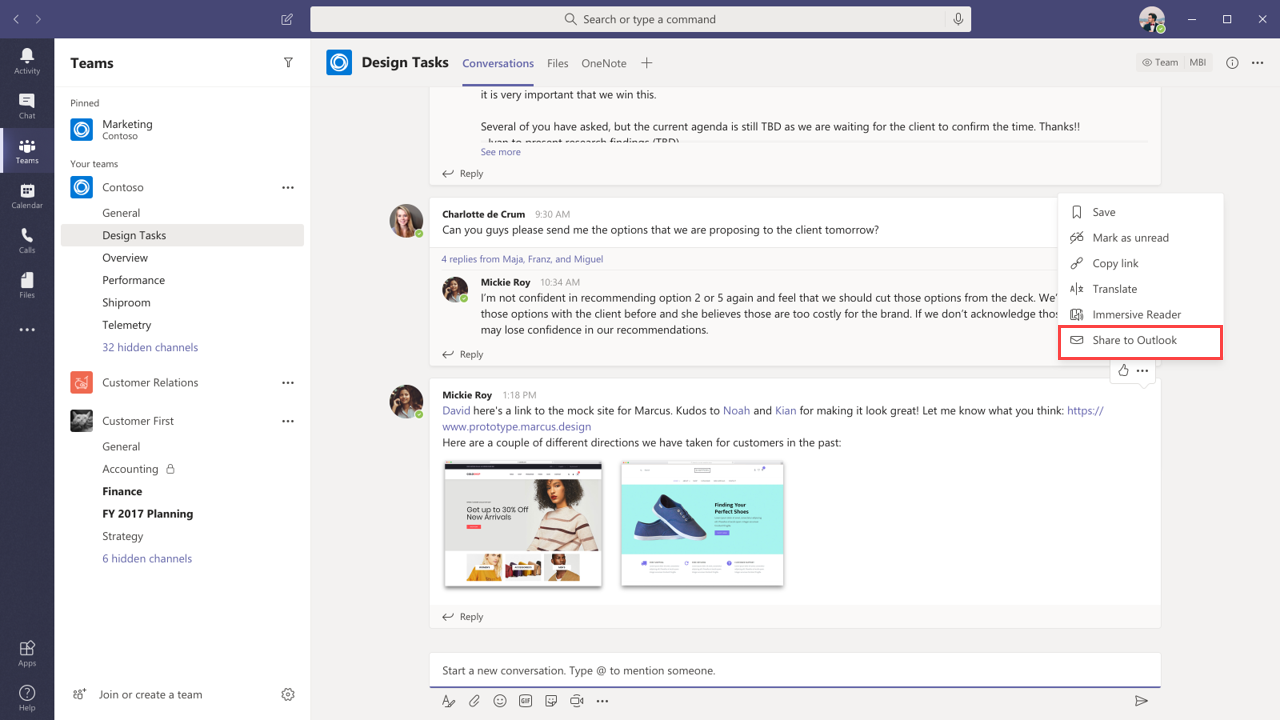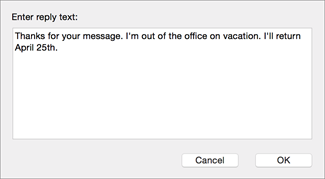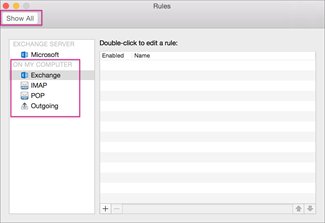

- #MICROSOFT OUTLOOK FOR MAC SET UP RULE FOR RESPONDING TO EMAIL UPDATE#
- #MICROSOFT OUTLOOK FOR MAC SET UP RULE FOR RESPONDING TO EMAIL CODE#
Doing so will insert the template's contents into the body of your email instead of attaching the document to it. From the Insert drop-down, click Insert As Text.Locate the template file and select it but don't click Open yet!.

Click the Insert tab and then click Attach File in the Include group.
#MICROSOFT OUTLOOK FOR MAC SET UP RULE FOR RESPONDING TO EMAIL CODE#
For instance, you might want to insert existing styles from another template or HTML code for a banner. But sometimes you'll need a different route. So far, all the tips have dealt with opening a template, completing it, and then sending it.
Choose Macros from the Choose Commands drop-down. Choose More Commands from the QAT drop-down. If you don't want to customize the Ribbon, you can customize the Quick Access Toolbar, as follows: 6: Add a shortcut to the Quick Access Toolbar Outlook will place a Templates group on the Home tab, as shown in Figure A.Īdd a new group for templates to the Ribbon. Right-click the macro (in the Templates group now), choose Rename, and enter a short, but descriptive name. 
With the new Templates group still selected, choose All Commands from the Choose Commands drop-down and select Macros.You can use the arrows to the right to move it. By default, Outlook will position the new group at the end of the Ribbon. Click New Group, choose Rename, enter a name such as Templates, and click OK.Select Customize Ribbon in the left pane.Click the File tab and then click Options under Help in the left pane.With the macro in place, add a custom group to the Ribbon as follows:
#MICROSOFT OUTLOOK FOR MAC SET UP RULE FOR RESPONDING TO EMAIL UPDATE#
Update the Set myItem statement to reflect the name of your template but keep the IPM.Form component (that's the class). Set myFolder = Session.GetDefaultFolder(olFolderInbox)

The first thing you need is a macro use the following sub procedure as a guide: Sub OpenCustomTemplate() If you have several templates, add a custom group to the Ribbon for easy access. At this point, you can fill in any remaining information before sending. To use the Quick Step message as a template, select it from the options in the Quick Steps group - selecting it will open the generic message.
From the Shortcut Key drop-down, select a predefined shortcut, if you want one. From the Choose An Action drop-down, select New Message in the Respond section. In the Quick Steps group, choose the Create New option. Click the Home tab and then do the following: You can create a Quick Step (new to Outlook 2010) instead. Templates aren't the only way to access stock messages. There's no workaround delete the text signature from the template or disable the auto signature. Your messages will end up with two signatures. Outlook has no way of knowing that the text at the bottom of your template message is a signature. When creating template files, don't save a manually entered signature with the template if you have an auto signature enabled. It's a great shortcut, but use it wisely. In addition, a message in the Drafts folder is easy to delete. You'll save a few steps, but this tip works best with limited messages. (If you send it as usual, Outlook will delete the message from the Drafts folder.) Then, double-click the message in the Drafts folder, complete it, and click Forward to send it. Another option is to save your basic message in the Drafts folder. Opening a template, while more efficient than re-creating the message, takes several steps. Make the necessary changes to update the message and click Send as you normally would. Double-click the template or select it and click Open. From the Look In drop-down, select User Templates In File System. In Outlook 2007, select Choose Form from the New option's drop-down. In the Mail window, click the Home tab, choose More Items from the New Items drop-down in the New group, and then select Choose Forms from the resulting submenu. To use an existing template, do the following: Click Save and Outlook will save the template file to the default folder. From the Save As Type drop-down, choose Outlook Template (*.oft). Click the File tab or the Office button. Add the text and apply styles and formatting. Creating template files for reuse is an easy process: Message templates let you create and store information you send regularly. These tips will help you put templates to work for you. You'll save time and reduce potential input errors. Create a template and base new messages on it. If you send the same information or use the same styles and formatting repeatedly, don't re-create the effort every time you send an email.








 0 kommentar(er)
0 kommentar(er)
